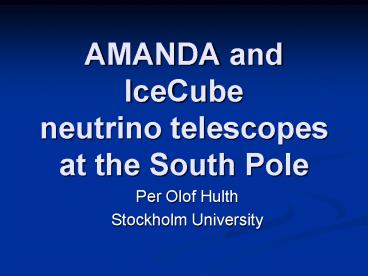AMANDA and IceCube neutrino telescopes at the South Pole - PowerPoint PPT Presentation
1 / 25
Title:
AMANDA and IceCube neutrino telescopes at the South Pole
Description:
Preamplifiers designed and built in Stockholm (SWAMPS) ... Amplified 100 times by Stockholm 'SWAMP' (Lars Thollander) Technical requirements ... – PowerPoint PPT presentation
Number of Views:32
Avg rating:3.0/5.0
Title: AMANDA and IceCube neutrino telescopes at the South Pole
1
AMANDA and IceCube neutrino telescopes at the
South Pole
- Per Olof Hulth
- Stockholm University
2
Members of the AMANDA SU group
- Senior members
- Christian Bohm
- Per Olof Hulth
- Klas Hultqvist
- Christian Walck
- Forskarassistent
- Stephan Hundertmark
- Resarch students
- Thomas Burgess
- Patrik Ekström (Wuppertal)
- Yulia Minaeva
- Julio Rodriguez Martino
- Christin Wiedemann
- Electronic engenieer
- Lars Thollander
3
Scientific goal
- Detect High Energy cosmic neutrinos by using the
ice sheet at The South Pole as a target. - Method
- Detect the emitted Cherenkov light from neutrino
induced interactions in the ice.
4
Activities
- Mainly analysis and software development
- Preamplifiers designed and built in Stockholm
(SWAMPS)
5
Short summary of neutrinos for pedestrians
- There are three different families of leptons
- Electron neutrino (?e) and the electron (e-)
- Muon neutrino (??) and the muon (?-)
- Tau neutrino (??) and the tau (?-)
6
Neutrino interaction
??
??
lt 1 degree
The muon can travel several km in e.g. ice
7
Cherenkov radiation
A charged particle moving with the speed of light
in the medium will generate a shock wave of light
q
cosq 1/(nb) b v/c, n refraction index
8
South Pole
Dark sector
Skiway
AMANDA
Dome
IceCube
9
myon
neutrino
10
106 muons from cosmic rays per muon from
neutrinos !!!!
myon
Select only muons from below!!!! Except for
high Energies
neutrino
11
Hot water heaters
-50 m
-55 C
1400 m
-42C
-20 C
-2400 m
12
Photomultipliers Hamamatsu 20 cm 14 dynodes Gain
109
13
AMANDA electronics
- Three different cable types (2400 -2600 m)
- Strings 1-4 coax cable, rise time 250 ns
- Strings 5-10 twisted pair rise time, 50-70 ns
- Strings 11-19 twisted pair rise time 100-150 ns
- Analog signal at surface about 1-10 mV
- Amplified 100 times by Stockholm
SWAMP (Lars Thollander)
14
Technical requirements
- Absolute timing lt7 ns from any OM
- Geometrical position uncertainty lt 1m
- Electronic in ice should stand -50 C
- Low noise
15
Building AMANDA The Optical Module and the String
16
Evolution of read-out strategy
Strings 1-10 Strings 11-17,19
String 18
17
New Project IceCube
- Increase volume to 1 km3
- 80 strings with 60 modules each
- Photomultiplier 25 cm (10 inch) 10 dynodes
(preliminary Hamamatsu) - Air shower detector on top (IceTop)
- Transport drill to Pole 03/04
- First 1-7 strings in 04/05
18
IceTop
AMANDA
South Pole
IceCube
Skiway
80 Strings 4800 PMT
1400 m
2400 m
19
IceCubeTop View
80 strings 60 modules/string Volume 1 km3 Depth
1400-2400 m
Counting House
20
µ-events in IceCube
Eµ6 PeV
Eµ10 TeV
AMANDA-II
1 km
Measure energy by counting the number of fired
PMT. (This is a very simple but robust method)
21
1. Digital Optical Module
- Self-triggers on each pulse
- Captures waveforms
- Time-stamps each pulse
- Digitizes waveforms
- Performs feature extraction
- Buffers data
- Responds to Surface DAQ
- Set PMT HV, threshold, etc
- Noise rate in situ 500 Hz
DOM
33 cm
22
IceCube String
1400 m
OM Spacing 17 m
2400 m
23
Experimental Requirements IceCube
- Time resolution lt5 ns rms
- Waveform capture
- gt250 MHz - for first 500 ns
- 40 MHz - for 5000 ns
- Dynamic Range
- gt200 PE / 15 ns
- gt2000 PE / 5000 ns
- Dead-time lt 1
- OM noise rate lt 500 Hz (40K in glass sphere)
24
2. DAQ Network architecture
25
In-Door deployment
26
Hose Winch for the Ice Cube Project
27
Receiving drum weldment
28
POSITION OF DRILL(30HOUR ANALYSIS)































